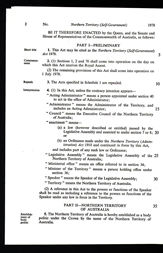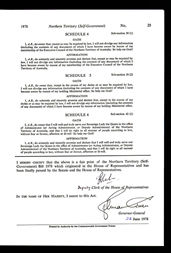

Northern Territory (Self-Government) Act 1978 (Cth)
Significance
This document provided the legal basis for responsible government in the Northern Territory, bringing the Territory government closer to the model of State government in Australia.
History
In 1942 the danger of Japanese invasion led to the evacuation of Darwin’s civilian population and the imposition of military rule in the Northern Territory. With the end of World War II and the return of the Administration and the civilian population to Darwin, local pressures grew for political advancement. The Chifley Government was not unsympathetic but retained strong central control. After Cabinet and Departmental discussion in 1946, the Government amended the 1910 Northern Territory (Administration) Act in 1947 to provide for a Northern Territory Legislative Council.The membership, voting procedures and legislative restrictions ensured federal hegemony. Of the 13 Council members, seven were official appointees and six elected representatives. The Administrator was Chairman (later President) and had a casting as well as a deliberative vote. All legislation had to be assented to by the Administrator and could be disallowed within six months. Bills could be reserved for Commonwealth government review and such reservation was compulsory for measures relating to Aboriginal people or to Crown lands. Moreover, all proposals containing financial provisions had to have the Administrator's approval; the Commonwealth reserved the power to pass laws relating to Territory affairs through the Federal Parliament.
From 1947 until 1974, the pattern of constitutional advance was largely one of increasing the Council's size and altering its membership. From the beginning, the elected Council members put political allegiance second to political advance for the Territory. They filibustered, they obstructed government business, they petitioned, they set up a select committee to demand greater autonomy. In April 1958 they resigned their seats en masse, to be promptly re-elected by their constituents.
After that episode, Minister for Territories Paul Hasluck invited the whole Council to discussions in Canberra. They returned with the promise of a new Council structure; eight elected members, six official nominees and three unofficial nominees, to be drawn from outside the Public Service. Dissatisfied, elected members continued their protests, which reached new heights of ingenuity in a 1962 Remonstrance, a long-disused British parliamentary device for airing grievances. Incremental change continued. In 1965 the Administrator left the Council, to be replaced by an elected President. In 1968 three additional elected members replaced the unofficial nominees.
In 1974, the Whitlam Government bestowed a fully elected Legislative Assembly on the Territory but real power remained with the Commonwealth until 1978 when the Fraser Government enacted this law. The new Territory Government received most state-type powers except those over health services, education (both transferred to Northern Territory control in 1979) and the thorniest of all political areas by then, Aboriginal affairs. Aboriginal policy remains under Commonwealth control and the subordinate status of the Northern Territory is emphasised by the Federal Parliament's power and willingness to overrule Territory legislation, such as the euthanasia case in 1999.
These problems continue to prompt demands for statehood, though that cause received a setback in the failure of the Territory's 1998 Statehood Referendum.
Sources
Heatley, Alistair, Almost Australians: The Politics of Northern Territory Self-government, Australian National University, North Australia Research Unit, Darwin, 1990.
Heatley, Alistair, The Government of the Northern Territory, University of Queensland Press, Brisbane, 1979.
Heatley, Alistair, The Territory Party: The Northern Territory Country Liberal Party 1974–1998, Northern Territory University Press, Darwin, 1998.
Heatley, Alistair and Nicholson, Graham, Selected Constitutional Documents on the Northern Territory, Northern Territory Department of Law, Darwin, 1989.
Powell, Alan, Far Country: A Short History of the Northern Territory, Melbourne University Press, Melbourne, 1996.
Description
| Long Title: | An Act to provide for the Government of the Northern Territory of Australia, and for related purposes. (No. 58 of 1978) |
| No. of pages: | 26 + cover |
| Medium: | Paper |
| Measurements: | 24.5 x 17.5 cm |
| Provenance: | House of Representatives |
| Features: | Signature on p.25 |
| Location & Copyright: | National Archives of Australia |
| Reference: | NAA A1559/1, 1978/58 |





